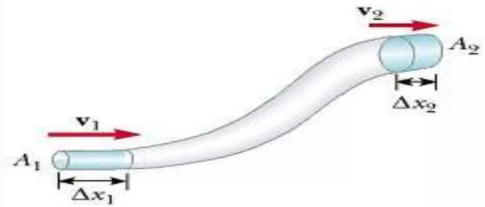The nature of the movement of physical quantities is defined by the continuity equation. The conserved quantities are usually used, however, extensive quantities can also be generalized. The main conserved quantities include mass, momentum, energy, and electric charge. To describe nature and other physical phenomena, a continuity equation can be used.
The continuity equation plays an important role to study the movement of fluids, mainly when fluid is passed through a tube or pipe of varying diameters or thicknesses.
What is Continuity Equation?
The equation of continuity states that the product of the area of the pipe and the speed of the fluid at all points along the pipe is a constant for an incompressible liquid.
This product is equal to the volume flow rate which is the amount of fluid that passes from a certain point in a unit of time. The continuity equation is generally used in pipes or tubes.
The continuity equation is written as
Where
is the volume flow rate
is the flow cross-sectional area of a point in the pipe
is the flow velocity at which fluid is flowing inside the pipe
Derivation of the Continuity Equation
Considers that a liquid is flowing through a pipe of varying thickness in a short interval of time as . Let the liquid enter with velocity and covers a distance of and leave with velocity and covers a distance of .
The cross-sectional area of the pipe is and .
The distance covered by the liquid is:
Now the volume of the liquid that flows at the lower end of the pipe will be:
As we know that,
Therefore, the mass of the liquid through the region in time will be:
Similarly, the mass of the liquid through the region in time will be:
Now by conservation of mass in fluid mechanics and as the flow is steady, the mass of lower end and the mass of the upper end is equal. That is,
As the fluid is incompressible. So,
This is the expression of the equation of continuity for a steady flow of incompressible liquid. This indicates that the velocity of the flow of liquid is inversely proportional to the cross-sectional area.
It can be expressed generally as,
Now if is the volume flow rate, hence the above equation can be written as
Continuity Equation in Cylindrical Coordinates:
The continuity equation in cylindrical coordinates can be written as:
Incompressible Flow Continuity Equation:
The continuity equation for incompressible flow as the density, ρ is constant and also independent of space and time, thus we get:
Steady Flow Continuity Equation:
In cylindrical coordinates, the continuity equation is expressed as follows:
Assumption of Continuity Equation
The following are the assumptions of the continuity equation:
- The two end of the pipe has a single entry and single exit
- The fluid that flows in the pipe is non-viscous.
- The flow is incompressible.
- The flow of the fluid is steady.
Applications of the derivation of the continuity equation
- Equation of Continuity has primary usage is in the various fields of physics like Hydrodynamics, Aerodynamics, Electromagnetism, and Quantum Mechanics.
- It is the fundamental rule of Bernoulli’s Principle, it is indirectly involved in the Aerodynamics principles and applications.
- To check the consistency of Maxwell’s Equation, it can be used as the differential form of the continuity equation in Electromagnetism.
- The continuity equation is used to check the consistency of the Schrodinger Equation.
Solved Example
Question. Water runs through a tube of a cross-sectional area of with a velocity of . Determine the water flow rate in the pipe when the cross-sectional area is down to .
Solution. Using the formula,
Recommended Articles:
Derivation of Beer Lambert Law: Statement, Statement, Derivation
Derivation of Bending Equations: Assumptions, Applications, And Frequently
Derivation Of Biot Savart Law: Application, Importance, FAQ
Centripetal Acceleration: Introduction, Force, Derivation, And Applications
The Compton Effect: Introduction, Experiment, Derivation, Shift, And Confirmation
The continuity equation is used in fluid dynamics. Use of the continuity equation is as follows: It can also be seen when calculating how much blood the heart pumps into the vessels that can determine the health of the person. This is also useful to determine the clogged blood vessel and then take measures against issues in the heart. The two types of flux in the continuity equation are Volumetric Flux and Mass Flux. The continuity equation is written as Where is the volume flow rate is the flow cross-sectional area of a point in the pipe is the flow velocity at which fluid is flowing inside the pipe The flow of the fluid is steady. Derivation Of Continuity Equation FAQs
The equation of continuity is used in which field?
What is the use of the continuity equation?
It is also found in immense water sources like rivers, lakes, and many more.
It can also be used in power plants, roadway logistics, and others.
Modern technologies, such as semiconductor technologies, use continuity equations.What are the types of flux in the continuity equation?
Write the continuity equation.
From the assumption of the continuity equation, what will be the nature of the fluid flow?
